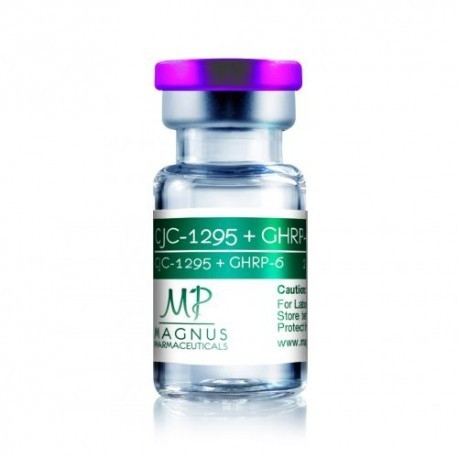CJC-1295 + GHRP-6
€ 54.00
New product
TYPE:
Injectable
CATEGORY:
HGH & Peptides
SUBSTANCE:
GHRP
MANUFACTURER:
Magnus Pharmaceuticals
More info
CJC1295 +GHRP-6
Description
CJC1295 has shown some amazing results as a growth hormone releasing hormone (GHRH) analog. Not only has CJC 1295 shown potential to increase growth hormone and IGF-1 secretion and effects, but it has been able to do so very large amounts.
CJC 1295 is a tetrasubsituted 30-amino acid peptide hormone, primarily functioning as a growth hormone releasing hormone (GHRH) analog
One of the advantages of CJC 1295 over traditional GHRH or rHGH is its ability to bioconjugate with serum albumin, thus increasing its half-life and therapeutic window. It accomplishes this by using protecting groups around the amino acids of GHRH typically susceptible to enzymatic degradation.
Another benefit of CJC 1295 is its ability to promote slow wave sleep. Slow wave sleep is also known as deep sleep and is the portion of sleep responsible for the highest level of muscle growth and memory retention. SWS decreases significantly in older adults and also with people who tend to exercise later in the evening. Clinical studies have shown that a once-daily administration of CJC 1295 normalizes the GHRH response and can induce significantly deeper sleep.
Clinical Research
Prolonged Stimulation of Growth Hormone (GH) and Insulin-Like Growth Factor I Secretion by CJC 1295, a Long-Acting Analog of GH-Releasing Hormone, in Healthy Adults – Sam L. Teichman, Ann Neale, Betty Lawrence, Catherine Gagnon, Jean-Paul Castaigne, and Lawrence A. Frohman.
WinPharm Associates (S.L.T., A.N.), Alamo, California 94507; ConjuChem, Inc. (B.L., C.G., J.-P.C.), Montre´al, Que´be´c, Canada; and Section of Endocrinology, Department of Medicine, University of Illinois (L.A.F.), Chicago, Illinois 60612
Context: Therapeutic use of GHRH to enhance GH secretion is limited by its short duration of action.
Objective: The objective of this study was to examine the pharmacokinetic profile, pharmacodynamic effects, and safety of CJC 1295, a long-acting GHRH analog.
Design: The study design was two randomized, placebo-controlled, double blind, ascending dose trials with durations of 28 and 49 d.
Interventions: CJC 1295 or placebo was administered sc in one of four ascending single doses in the first study and in two or three weekly or biweekly doses in the second study.
Main Outcome Measures: The main outcome measures were peak concentrations and area under the curve of GH and IGF-I; standard pharmacokinetic parameters were used for CJC 1295.
Results: After a single injection of CJC 1295, there were dose dependent increases in mean plasma GH concentrations by 2- to 10-fold for 6 d or more and in mean plasma IGF-I concentrations by 1.5- to 3-fold for 9–11 d. The estimated half-life of CJC 1295 was 5.8–8.1 d. After multiple CJC 1295 doses, mean IGF-I levels remained above baseline for up to 28 d. No serious adverse reactions were reported.
Conclusions: Subcutaneous administration of CJC 1295 resulted in sustained, dose-dependent increases in GH and IGF-I levels in healthy adults and was safe and relatively well tolerated, particularly at doses of 30 or 60 ug/ kg. There was evidence of a cumulative effect after multiple doses. These data support the potential utility of CJC 1295 as a therapeutic agent.
Reviews
No customer reviews for the moment.



